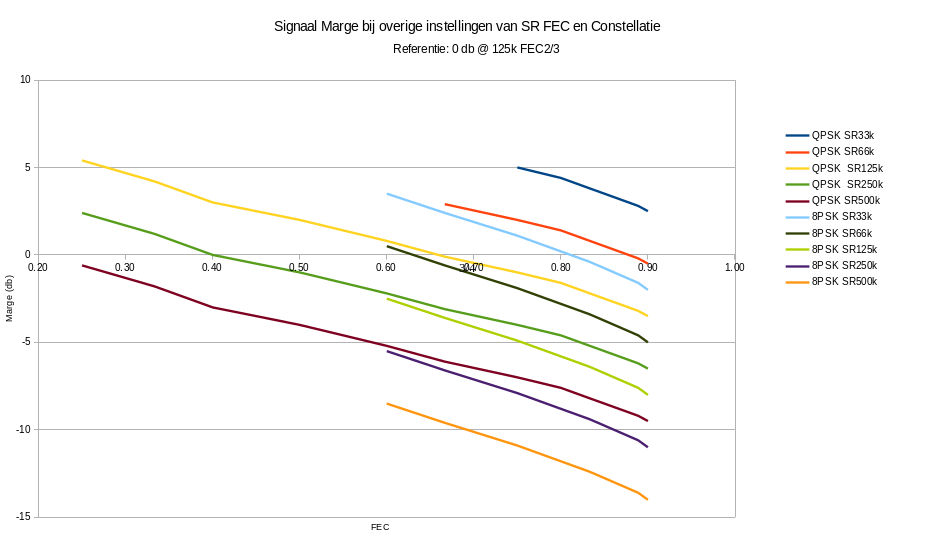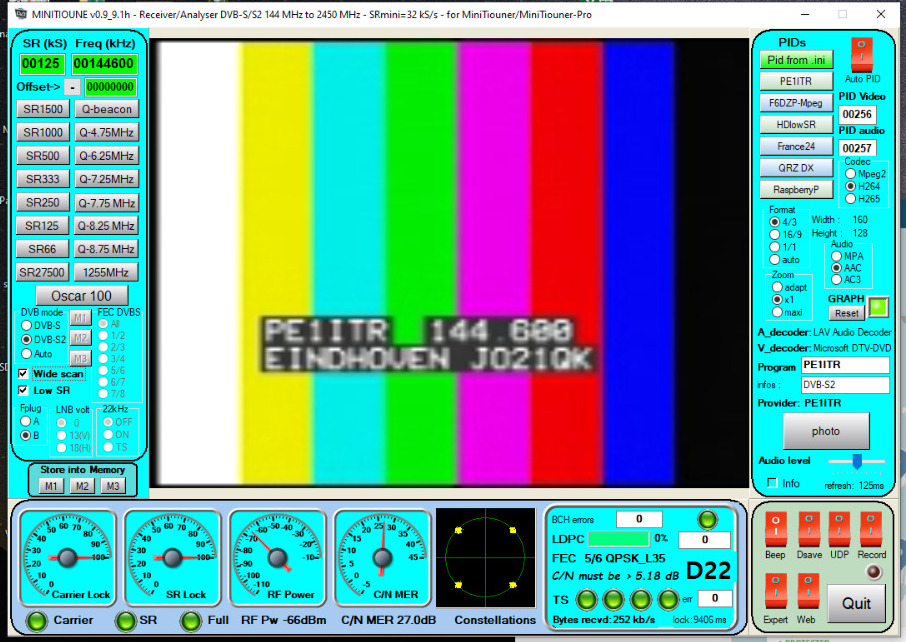DATV DX-ing and settings
(2020-07-12) PE1ITR
Preface
To note that we are talking about transferring moving images here. :-) So no still pictures as with slow scan television.
Reference to my 51 and 144 MHz DATV station.
Which DVB-S2 settings are best for receiving a station at a long distance? The signals will then not be strong and will also be subject to propagation phenomena such as fading, multipath. It is known that DVB-S2 is not robust for multi-pad phenomena. So far I have the best experience with DVB-S2, symbole rate 125k, FEC 1/2. But can this be done better?
One strategy may be to use a low bit rate to improve the signal to noise level. But is this the best strategy when dealing with short rising of the signal levels by QSB? We also have other settings such as the FEC, type of constellation, use of pilots. What can we do with that? Is it better to send a lot of error correction information to deal with dropouts in the data stream or is it better to do this as little as possible so that we also have an image in a good moment? On this page an exploration of the settings and the results of a practical tests.
We also have to deal with other users with whom we share the band. These signals may interfere our DATV DX activity's. To what extent can we deal with this interference.
DVB-S2 is designed for broadcast services and not for DX. Powerful in DVB-S2 is the use of modern LDPC coding. This gives a better SNR. Although it is useful, I think that we should not stick to the commercially developed standards when we think of special use within the amateur service such as DATV DX-ing. For the time being nice to experiment with this.
Settings
The graph below shows the theoretical margin in db compared to an SR 125k FEC 2/3 signal. It is clear that with a constant SR the strong FEC ratios give a better SNR. The low bit rates also gives a better SNR.
FEC = forward error correction. DVB-S2 has two layers of FEC. There is FEC in the BCH encoding layer. And there is FEC in the LDPC encoding layer.
A block of frame in this last layer consists of 64 800 bits for normal FECFRAME and 16 200 bits for short FECFRAME. The FEC value determines how much video data is sent in a data block compared to correction data in order to be able to restore the video data at dropouts. In the DVB-S2 standard, blocks of data are broadcast. At an FEC of 1/4, a quarter of the data in one block is used for video, and the rest is overhead correction information. With an FEC of 9/10, 9/10 of the data in one block is used for video and the rest for correction information. An FEC of 1/4 is therefore more powerful than 8/9 for dealing with any faults. A strong FEC gives the best SNR. However, the amount of actual video information in a timeframe is much less.
For DX, a low bitrate seems to be an advantage because the bandwidth is small. With a lower bandwidth, the SNR is more favorable. However, a low bite rate also limits the amount of video data that you can broadcast over time. In order to get sufficient video quality, the FEC must be set less powerful. This is at the expense of the SNR. So it is a trade-off that you have to make for the desired result.
My experience now is that a symbol rate of 125k in combination with a strong FEC gives the best result when it comes to DATV DX. This was followed by 66 k with a slightly less strong FEC. At 33k symbol rate you are forced to set a weak FEC. This means that the required SNR has become so high that it is actually unsuitable for DATV DX.
The pilot encoding in a DVB-S2 signal gives an advantage for the frame synchronization or carrier recovery, but this extra 2.4% data is also at the expense of the amount of video information in a block. So at low bitrates it seems better to turn these off. It is interesting to study the effect of this with certain propagation. I can imagine that with fast QSB and when you have a good signal in a flare it can be an advantage to enable this option.

Practice Test
On July 12, I conducted a test with Joris, PE1GLX as a counter station. PE1GLX is 7 km away and was the receiving station. PE1ITR the sending station at 144.600 MHz. At the transmitter, PE1ITR we set the signal level at PE1GLX so that it was above the threshold at SR 125 kHz FEC 1/2. Level was 2.4 db. I was running 200 mW output.
In the test I tried different settings. A finding is that an SR 125 kHz with a strong FEC beats SR 66k with a less strong FEC. It turns out that you can put too little video information in a block at a low bit rate if you use a too strong FEC. It turned out that 66k FEC 3/5 was just going. But 66k FEC 1/2 resulted in no picture. The SR 33 KHz resulted in any case at the low signal levels at no image information at the receiver and proved useless in that sense.
So 125 kHz FEC 1/2 wins of 66 kHz FEC 3/5. And for the even lower signal levels, 125 kHz with FEC 1/3 and even 1/4 is also possible. So 125 kHz is a nice value for DATV DX-ing.

This picture is made by PE1GLX. PE1ITR with 200w output 125k FEC 5/6.
Conclusion
For DATV DX-ing I use initially at 2m DVB-S2 Symbol rate 125 KHz with an FEC of 1/3. An FEC of 1/4 does not always go well at the receiver.
Extra information
Digital Video Broadcasting (DVB);Second generation framing structure, channel coding and modulation systems for Broadcasting ... ETSI EN 302 307.
HOME | Go Back

